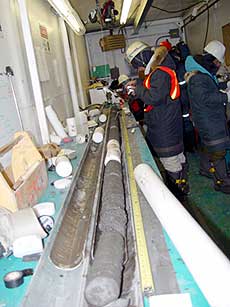 December 11, 2003
Wednesday at a symposium in Japan, the successful results of the first modern, fully integrated production testing of gas hydrates were being discussed by an international gathering of research scientists. The international consortium, including the USGS, the Department of Energy, Canada, Japan, India, Germany, and the energy industry conducted test drilling at a site known as Mallik, in the Mackenzie Delta of the Canadian Arctic. This location was chosen because it has one of the highest concentrations of known gas hydrates in the world. The United States is committed to participating in international research programs such as this one to advance the understanding of natural gas hydrates and the development of these resources. Even though gas hydrates are known to occur in numerous marine and Arctic settings, little was known before the Mallik project about the technology necessary to produce gas hydrates. The successful results from this research form the world's most detailed scientific information about the occurrence and production characteristics of gas hydrates. The estimated amount of natural gas in the gas hydrate accumulations of the world greatly exceeds the volume of all known conventional gas resources. While gas hydrates hold great potential as an "environmentally-friendly" fuel for the 21st Century, the technical challenges of realizing them as a resource are substantial. Additional research is required to understand and develop new techniques to quantify their distribution in nature. Depressurization and thermal
heating experiments at the Mallik site were extremely successful.
The results demonstrated that gas can be produced from
gas hydrates with different concentrations and characteristics,
exclusively through pressure stimulation. The data supports the
interpretation that the gas hydrates are much more permeable
and conducive to flow from pressure stimulation than previously
thought. In one test, the gas production rates were substantially
enhanced by artificially fracturing the reservoir.
Source of News Release:
|
||
